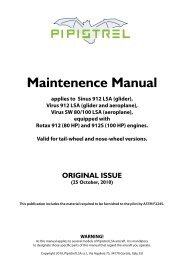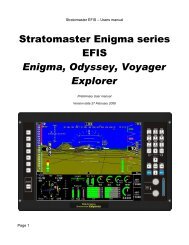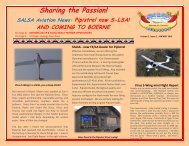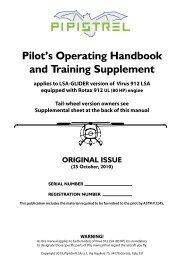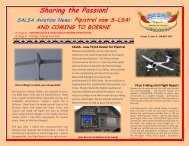Pipistrel Virus Aircraft Operating Instruction - Salsa Aviation
Pipistrel Virus Aircraft Operating Instruction - Salsa Aviation
Pipistrel Virus Aircraft Operating Instruction - Salsa Aviation
Create successful ePaper yourself
Turn your PDF publications into a flip-book with our unique Google optimized e-Paper software.
AIRCRAFT OPERATING INSTRUCTIONS – VIRUS 912 S-LSA GLIDERGRS System descriptionThe GRS rocket charged parachute rescue system provides you with a chance to rescue yourself from anunexpected situation. The system is placed inside a durable cylinder mounted on the right hand side ofthe baggage compartment. Inside this cylinder is the parachute which stored inside a deployment bagwith a rocket engine underneath. This brand new design deploys a canopy that is not gradually drawnfrom the container, exposed to distortion by air currents, but it is safely open after 0.4 to 0.7 seconds indistance of 15-18 meters above the aircraft. It is carried there in a special deployment bag, whichdecreases the risk of aircraft debris fouling the canopy. The parachute rescue system is activatedmanually, by pulling the activation handle mounted on the back wall above. After being fired, the mancanopy is open and fully inflated in about 3.2 seconds.WARNING! Activation handle safety pin should be inserted when the aircraft is parked or hangared toprevent accidental deployment. However, the instant pilot boards the aircraft, safety pin MUST beremoved!Typical situations for use of the parachute rescue system are:structural failuremid-air collisionloss of control over aircraftengine failure over hostile terrainpilot incapacitation (incl. heart attack, stroke, temp. blindness, disorientation...)Prior to firing the system, provided time allows:shut down the engine and set master switch to OFF (key in full left position)shut both fuel valvesfasten safety harnesses tightlyprotect your face and body.To deploy the parachute jerk the activation handle hard to a length of at least 1 foot towards theinstrument panel.Once you have pulled the handle and the rocked is deployed, it will be about two seconds before you feelthe impact produced by two forces. The first force is produced by stretching of all the sys-tem. Thesecond force follows after the inflation of the canopy from opening impact and it will seem to you thatthe aircraft is pulled backwards briefly. The airspeed is reduced instantly and the aircraft now starts todescent underneath the canopy.CAUTION! Should you end up in power lines (carrying electrical current), DO NOT under anycircumstances touch any metal parts inside or outside the cockpit. This also applies to anyone attemptingto help or rescue you. Be aware that anyone touching any part of the aircraft while standing on theground will probably suffer mayor injury or die of electrocution. Therefore, you are strongly encouragedto confine your movements until qualified rescue personal arrives at the site to assist you.After the parachute rescue system has been used or if you suspect any possible damage to the sys-tem,do not hesitate and immediately contact the manufacturer!Page 48



